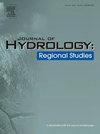Attribution analysis of hydrological drought after the impoundment of the Danjiangkou reservoir in the Hanjiang River Basin
IF 4.7
2区 地球科学
Q1 WATER RESOURCES
引用次数: 0
Abstract
Study region
Hanjiang River Basin, China
Study focus
Under the joint influences of human activities and climate change, droughts frequently occur in the Hanjiang River Basin (HRB). Quantifying the driving forces contribution on hydrological drought is crucial to enhance the early warning ability. This study employed the standardized streamflow index (SSI) to assess hydrological drought. The Soil and Water Assessment Tool (SWAT) model was utilized to reconstruct natural streamflow based on hydrological and meteorological data. By comparing the variations of drought characteristics in simulated and observed scenarios, the impacts of human activities and climate change to hydrological drought were quantified.
New hydrological insights for the study region
The SWAT model is capable of effectively simulating the natural streamflow conditions of the HRB with NSE>0.7, R2>0.8, logNSE>0.7 and |PBIAS|<20 %. Hydrological drought has intensified as a prolonged duration and greater severity affected by human activities and climate change. During the whole impact period (1968–2022), the duration and severity increased by 66.22 % and 81.16 % compared to baseline period (1956–1967). The year 1991 is detected as the mutation point. From 1968–1990 climate change has been the main factor in exacerbating hydrological drought. Since 1991, the influence of human activities has gradually exceeded the influence of climate change. These findings provide valuable insights for watershed integrated water resources management and water security.
汉江流域丹江口水库蓄水后水文干旱的归因分析
研究区域中国汉江流域研究重点在人类活动和气候变化的共同影响下,汉江流域干旱频发。量化水文干旱的驱动力对提高预警能力至关重要。本研究采用标准化流量指数(SSI)来评估水文干旱。根据水文和气象数据,利用水土评估工具 (SWAT) 模型重建了自然溪流。SWAT 模型能够有效地模拟 HRB 的自然流场条件,NSE>0.7、R2>0.8、logNSE>0.7 和 |PBIAS|<20 %。受人类活动和气候变化的影响,水文干旱加剧,持续时间延长,严重程度增加。与基线期(1956-1967 年)相比,整个影响期(1968-2022 年)的持续时间和严重程度分别增加了 66.22% 和 81.16%。1991 年是突变点。从 1968 年到 1990 年,气候变化是加剧水文干旱的主要因素。自 1991 年起,人类活动的影响逐渐超过气候变化的影响。这些发现为流域水资源综合管理和水安全提供了宝贵的启示。
本文章由计算机程序翻译,如有差异,请以英文原文为准。
求助全文
约1分钟内获得全文
求助全文
来源期刊

Journal of Hydrology-Regional Studies
Earth and Planetary Sciences-Earth and Planetary Sciences (miscellaneous)
CiteScore
6.70
自引率
8.50%
发文量
284
审稿时长
60 days
期刊介绍:
Journal of Hydrology: Regional Studies publishes original research papers enhancing the science of hydrology and aiming at region-specific problems, past and future conditions, analysis, review and solutions. The journal particularly welcomes research papers that deliver new insights into region-specific hydrological processes and responses to changing conditions, as well as contributions that incorporate interdisciplinarity and translational science.
 求助内容:
求助内容: 应助结果提醒方式:
应助结果提醒方式:


